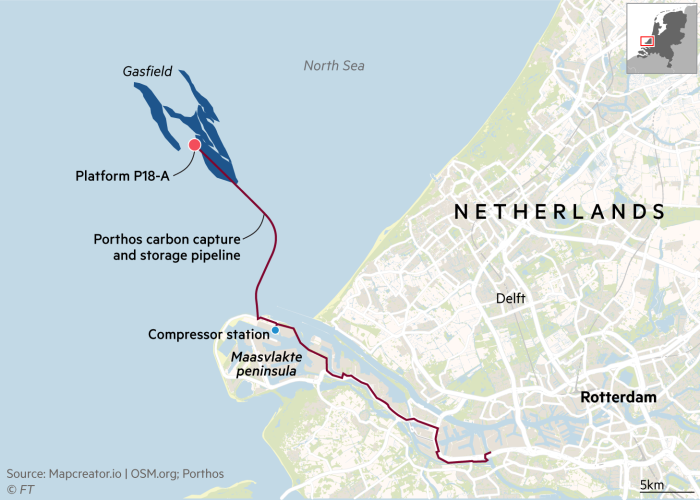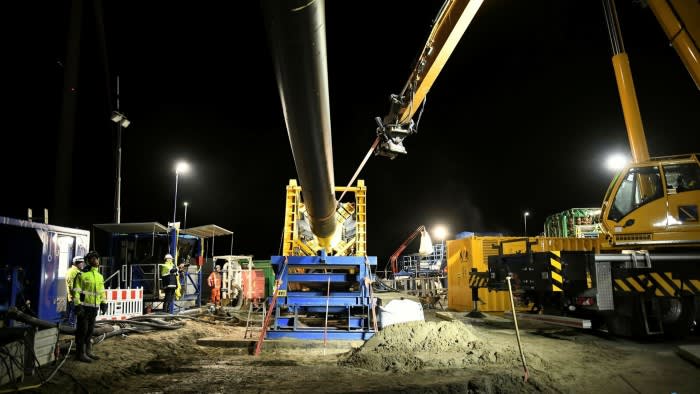Unlock the Editor’s Digest for free
Roula Khalaf, Editor of the FT, selects her favourite stories in this weekly newsletter.
On the edge of a man-made peninsula at Rotterdam port, engineers have started work on Europe’s most ambitious attempt at capturing and storing the carbon dioxide emissions behind climate change.
After significant delays, drilling started in mid-April to lay a 50km pipeline that will collect CO₂ emissions from the vast refineries and hydrogen plants around Europe’s largest port and inject them into a disused gasfield in the North Sea.
Shell, one of the biggest customers of the €1.3bn Porthos project, claims that it will capture more than 1mn tonnes a year of CO₂ from its Pernis refinery, the biggest in Europe and responsible for roughly a quarter of its annual emissions.
Porthos will be key to proving that carbon capture and storage (CCS) technology is a viable way to reduce emissions. The technology has existed for decades but has been difficult to finance. It is unpopular with environmentalists who argue that CCS enables oil companies to keep drilling.
“This is the first really big [CCS] project we have got,” said the Dutch government, which will make up the difference if the EU carbon price falls beneath the cost of the project. “It will serve as a test case for what is to come in the future.”
The International Energy Agency, which says such projects will play an important role in absorbing CO₂ from heavy industries such as steel, cement and fertiliser production that are difficult to decarbonise, has called for an “urgent” rollout of CCS schemes for those industries.
Over the 16 years it will take to fill the P18 gasfield, Porthos is projected to save 37mn tonnes of CO₂ from being released into the atmosphere, roughly equivalent to the annual emissions from driving 9mn petrol-fuelled cars.
But Andrew Reid, an analyst at the Institute for Energy Economics and Financial Analysis, cautioned that the project’s economics could turn sour if it failed to capture or store as much CO₂ as hoped
“There are some real risks or unknowns about storage which I don’t think will be solved quickly,” he said.

Porthos’ joint developers are Port of Rotterdam, Gasunie and EBN, all of which are partly state owned. Work on the Dutch project has begun at a pivotal moment, with dozens of other CCS schemes, many of them also in the North Sea, waiting for final investment decisions.
If the project succeeds, a second pipeline — called Aramis and already backed by Shell and Total — is planned in Rotterdam to a gasfield that could store more than 10 times as much CO₂. In the UK, 14 companies won 21 licences last September to use depleted North Sea fields with the potential to store up to 10 per cent of the UK’s annual CO₂ emissions.
Amin Nasser, President and CEO of Saudi Aramco, the world’s largest oil producer, told the World Energy Congress in the Dutch city this week that “carbon capture and storage or direct air capture . . . is going to work over the long term and we need to continue to build all these facilities and decarbonise” to help reach net zero emissions.
“If we focus on emissions . . . we can achieve a lot,” he said. However, he added that the world would still need oil and gas beyond 2050, the target set by countries at last year’s COP28 meeting to reach net zero emissions.
The IEA, however, predicts that even in its best-case scenario there will only be 420mn t/y of storage capacity by 2030, or the equivalent of only about 1 per cent of the 37.4bn tonnes of energy-related CO₂ emissions last year.
Fatih Birol, head of the IEA, has said the idea that CCS will allow oil production to continue at its current rate is “pure fantasy”.
Porthos’s costs have spiralled from an initial estimate of €500mn when the project was first proposed in 2017. Dorus Bakker, its chief financial officer, said this was largely because the project was delayed by a court challenge from activists concerned about the impact of building work on the port’s nitrogen levels.
“Pipeline materials and construction costs became considerably more expensive because the Ukraine war happened and global gas exploration increased to be independent from Russian gas,” he said. “Also we had to cancel a number of tenders and then retender — and that doesn’t make your project very attractive to contractors,” he added.
Despite the high project finance costs, Bakker forecasts that the three companies underwriting the project will make an annual return of 2.2 per cent.
And for the Netherlands, the project will go a long way to helping the country meet its climate goals.
The Dutch government has promised to reduce greenhouse gas emissions by 49 per cent by 2030 from 1990 levels, and 95 per cent by 2050.
“We do not have the luxury to choose,” the government said. “We realise we are in a good position [to develop CCS projects] because of all the empty gasfields.”



